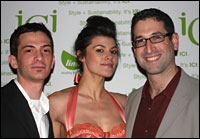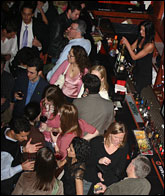Emily Gertz is a regular contributor to WorldChanging.com, and an internet content and strategy consultant for nonprofits. She has written on environmental policy for BushGreenwatch, and on the intersections of environment, culture, art, and activism for The Bear Deluxe and other independent alternative publications.

Thursday, 26 Jan 2006
New York, N.Y.
I have seen the future of the environmental movement, and it isn’t street demonstrators wearing polar-bear costumes. No, it is the Green Fairy: a very attractive brunette clothed in an outfit more reminiscent of a Playboy bunny than an Arctic animal, serving up tidbits of organic chocolate to a bar packed with urban hipsters.
The Green Fairy was dispensing her delicious wares Wednesday night at ICInyc, an event that billed itself as the first-ever gathering of “New York’s eco-conscious elite” — or at least environmentally aware somebodies from the worlds of media, fashion, arts, and design. These eco-modistes flowed in and out of up-to-the-minute hotspot Libation on Manhattan’s trendy Lower East Side over several hours, sipping organic vodka and wines while networking like crazy.
The party’s atmosphere was green meets scene: cross the average Green Drinks with the Vogue holiday party (or at least what you imagine the Vogue holiday party would look like), add the booming stylings of a guest DJ, mix in the roaming presence of an environmental-activist, fashion-model host clad in a revealing bustier-cum-minidress, and stir liberally with a sustainably grown bamboo swizzle stick. That was the ambiance at ICInyc, where the talk was of fashion-forwardly saving the planet.

Chuck Heckman and Josh Dorfman flank Summer Rayne Oakes.
Photos: Emily Gertz.
“We want people to experience sustainability in a new way,” said Chuck Heckman, who dreamed up ICInyc with four fellow eco-entrepreneurs: Summer Rayne Oakes (she of the astonishing bustier), Remy Chevalier, Josh Dorfman, and Graham Hill of Treehugger fame. “People want to have every facet of their lives reflect sustainability,” including their nightlife, said Heckman, whose company, Delano Collection, promotes high-style apparel and home furnishings made from sustainably sourced materials. And the wildfire growth of ICInyc’s guest list in the days leading up to the schmoozefest seemed to bear that out: as news of the party spread, sign-ups surged from about 400 on Monday to over 1,000 by the day of the party. By Wednesday night, the organizers were expecting around 1,400 people.
Oakes, a model intent on combining sexiness, sustainability, and style, spent the evening weaving her way around the animated crowd, posing for photos and talking up the ICInyc message: designers can mix their passion for cutting-edge aesthetics with ecological soundness — and there’s a consumer market ready to purchase the goods that result, and read about them in their glossy fashion and home magazines.
“We want to bring this to the level that the people at Elle and Vogue will listen to us,” confirmed Chevalier, who is editor at large and web editor for Electrifying Times, an electric-car zine. (Chevalier pioneered the mixing of hot New York nightlife and environmental consciousness, founding the “Eco-Saloon” series at the legendary Tribeca nightclub Wetlands in 1989.)
Dorfman, whose Vivavi company also retails sustainable furnishings, said his staff jokes about the “Burlap Sack Theory,” namely that “ecologically sound products have to suck.” He hoped ICInyc would show that “being fabulous and easy on the earth can be the same thing.” That the five presenters might generate some business for themselves in the process — they’ve been receiving inquiries about putting on similar events in other cities — seems perfectly in step with their eco-entrepreneurial approaches to changing the world.

Not a polar-bear costume in sight.
So were the “eco-elite” trying to be heard over the music at ICInyc talking about the latest in cradle-to-cradle materials, the rise of eco-fashion, or even the ecologically correct vodka? It was hard to tell over the thumping bass. But the place was packed; the party was a success, and its hosts had clearly tapped into something. After all, who wouldn’t want to save the world by drinking a great glass of wine and networking into a cool design job while surrounded by fabulously dressed people, instead of standing outside yelling at a protest rally?
Kazuki Kozuru seemed like just the kind of person the ICInyc organizers hoped to attract: a fashion designer living and freelancing in New York City who had never before “come to something environmental.” Standing above the thick of the action on Libation’s upper-level balcony, trying to spot the friend who’d invited her to the party, she said (yelled, actually) that she was interested in using sustainably produced fabrics, but “always thought that organic cottons were all sort of granola, sort of hippie.” If she had to choose between style and eco-correctness, she said, she’d opt for style every time. “But if you can make it pretty but also sustainable, why not?”
Had she made any good contacts yet at the party? “I’m waiting for something to happen,” Kozuru replied. “We’ll see.”


